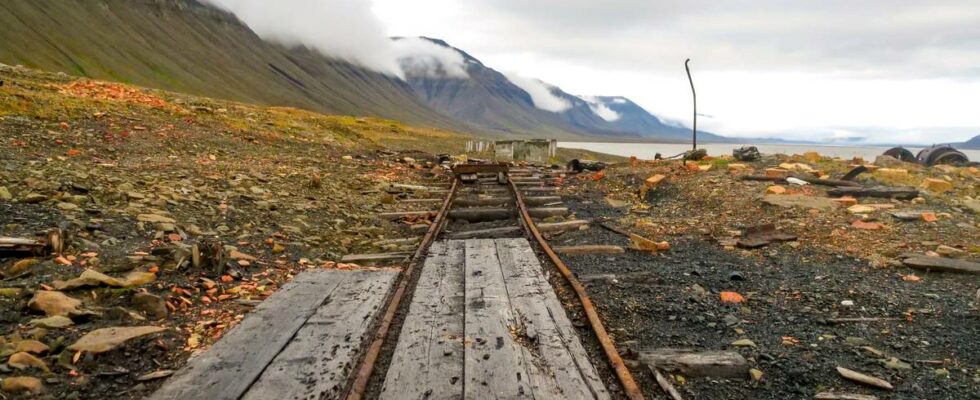– It is no longer enough to protect nature, we must also restore damaged nature, says Climate and Environment Minister Andreas Bjelland Eriksen. The enormous mining town of Svea, an area the size of Oslo, is to be returned to nature. Most of the traces of over 100 years of mining are now gone. On behalf of nature, the climate and environment minister received the official final report from Store norske Spitsbergen kullkompani this week. The environmental project has taken six years to complete: – Taking care of nature and restoring what has been destroyed is more and more important in the nature crisis we are now dealing with, says Eriksen to news. climate and environment minister Andreas Bjelland Eriksen was this week on an inspection in Svea on Spitsbergen to look at the restoration project. In the foreground is project manager in Svea, for Store Norske, Gudmund Løvli. Photo: Katinka Prestøy / Ministry of Climate and Environment / Ministry of Climate and Environment Source of inspiration The clean-up work has cost around NOK 1.6 billion. And there has been a lot to clean up. The industrial city in the heart of the Van Mijenfjord in Svalbard has over the years housed many and many things. At most there were over 400 people in the settlement. Loading of coal in Svea around 1920 from the Swedes’ first year of operation in the mine. Mentioned in the book “5 years on Spetsbergen” by Helmer Johanson. The picture from Johan Wegin, Helmer Johanson’s grandson. Photo: Helmer Johanson / Svalbard Museum But after more than 100 years, the mines in Svea have been closed and locked, and now most of the once huge community has returned to nature. Photo: Rune N. Andreassen / news Most of the infrastructure in Svea has been razed to the ground. Photo: Rune Nordgård Andreassen / news There has been a bustling life in Svea throughout the good years of coal mining. There were usually over 220 people at any one time in the mining community. Photo: Idar Nikolaisen After the clean-up, there are not many traces left of Svea’s long coal history. Photo: Jannicke Mikkelsen / news Once there was a bustling life, also far below the ground in Svea. Here from the mine in 2012. Photo: Tore Meek / Scanpix Mining on Svalbard has claimed many lives, including in Svea. The picture from a major fire in Svea Nord in 2018, where fortunately no lives were lost. Photo: Mikkel Aanderaa / Scanpix Now the airport, the power plant, the deep water quay and nearly 60 buildings have been demolished. Due to its desolate location, the mining town even had its own short-haul airport. Svea had a post office with its own associated postcode: 9175. There was also an infirmary, as well as varied leisure facilities with everything from a separate shooting club with associated shooting range, model flying club, bowling alley, and a modern training room. In March 2020, the last mine, Svea Nord, was finally closed. All the mines have been emptied of equipment and the entrances sealed. – When we manage to restore an old mining town back to nature in the Arctic, with the logistical challenges that are there, we can manage it on the mainland as well, says the climate and environment minister. Only three preserved buildings from before the Second World War remain in Svea. Photo: Jannicke Mikkelsen In Svea, buildings from before 1945 are automatically protected. In addition, there are archaeological traces both on and below ground. – Now nature has taken the area back, but we think it’s great that there are still some traces of the exciting history here, says national antiquarian Hanna Geiran. Mining in Svea In 1917, the plant was founded by the Swedish company Aktiebolaget Spetsbergens Svenska Kolfält. Store Norske bought Sveagruva in 1934 for NOK 1 million. At most, there were 400 employees in Svea, which is located deep in the Van Mijenfjorden on Svalbard. The last litter came out of Svea Nord on 8 April 2016. By then a total of approx. 32 million tonnes. It was in connection with the state budget for 2018 that the Storting decided to wind down mining in Svea and Lunckefjell. Source: Store Norske The clean-up work after the mining operations of Store Norske Spitsbergen Kulkompani in Svea is Norway’s largest initiative to restore nature. – It is a fantastic inspiration for many of the other nature restoration projects that we have the potential to carry out in Norway, says Bjelland Eriksen to news. Climate and Environment Minister Andreas Bjelland Eriksen (Ap) is shown around Svea by project manager Gudmund Løvli. Photo: The Ministry of Climate and Environment Store Norske has been responsible for the implementation of the project. And many of those who have taken part in the clean-up have themselves worked with mining in Svea. – I think there are many who think it has been painful. After all, they are cleaning out their own, former workplace. At the same time, there are many people who have been involved, and I have got the impression that they thought it was an exciting assignment, says project manager Gudmund Løvli. Published 24/08/2024, at 07.59 Updated 24.08.2024, at 12.41
ttn-69
The mining town of Svea in Svalbard left to nature – news Troms and Finnmark

